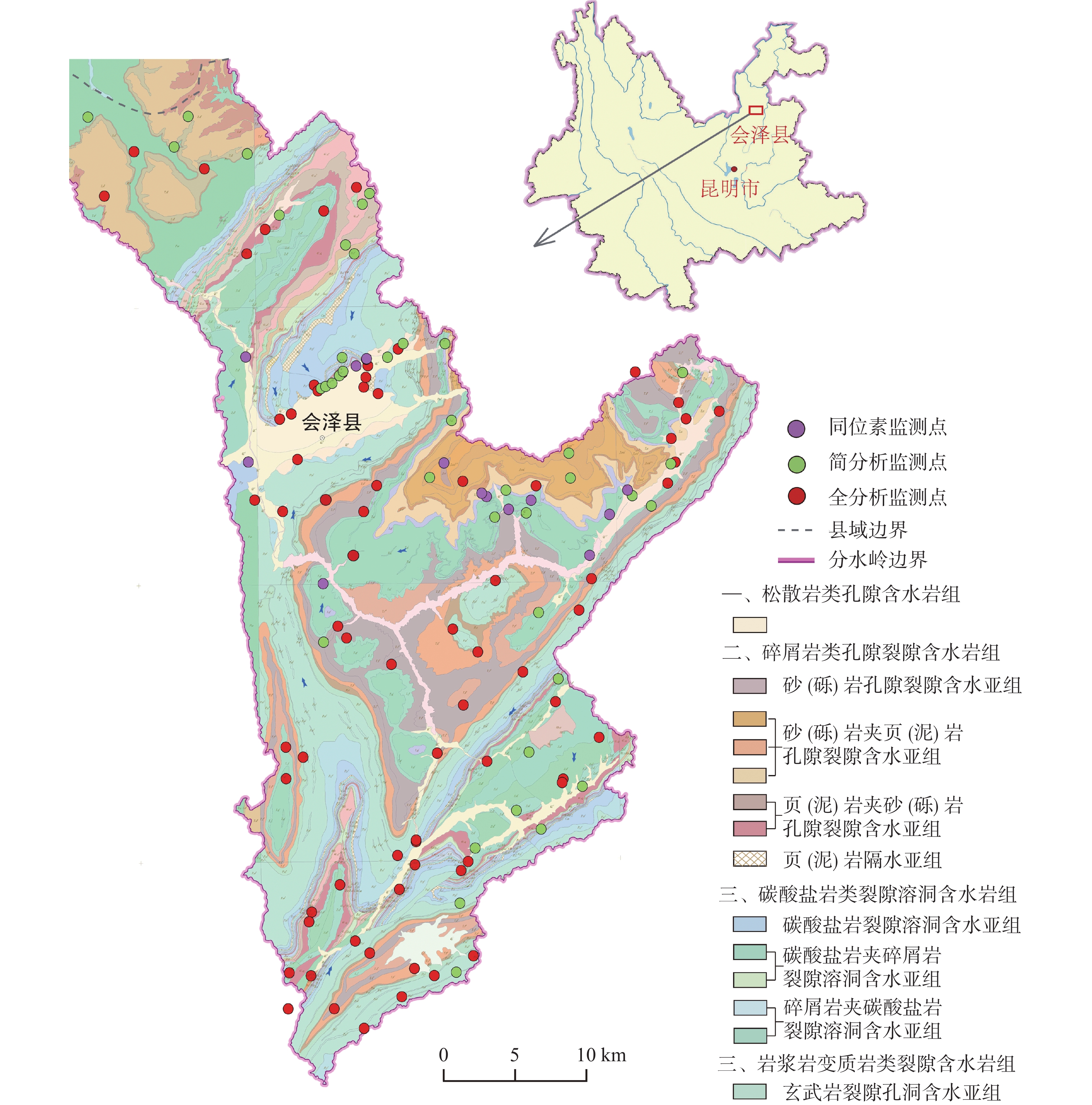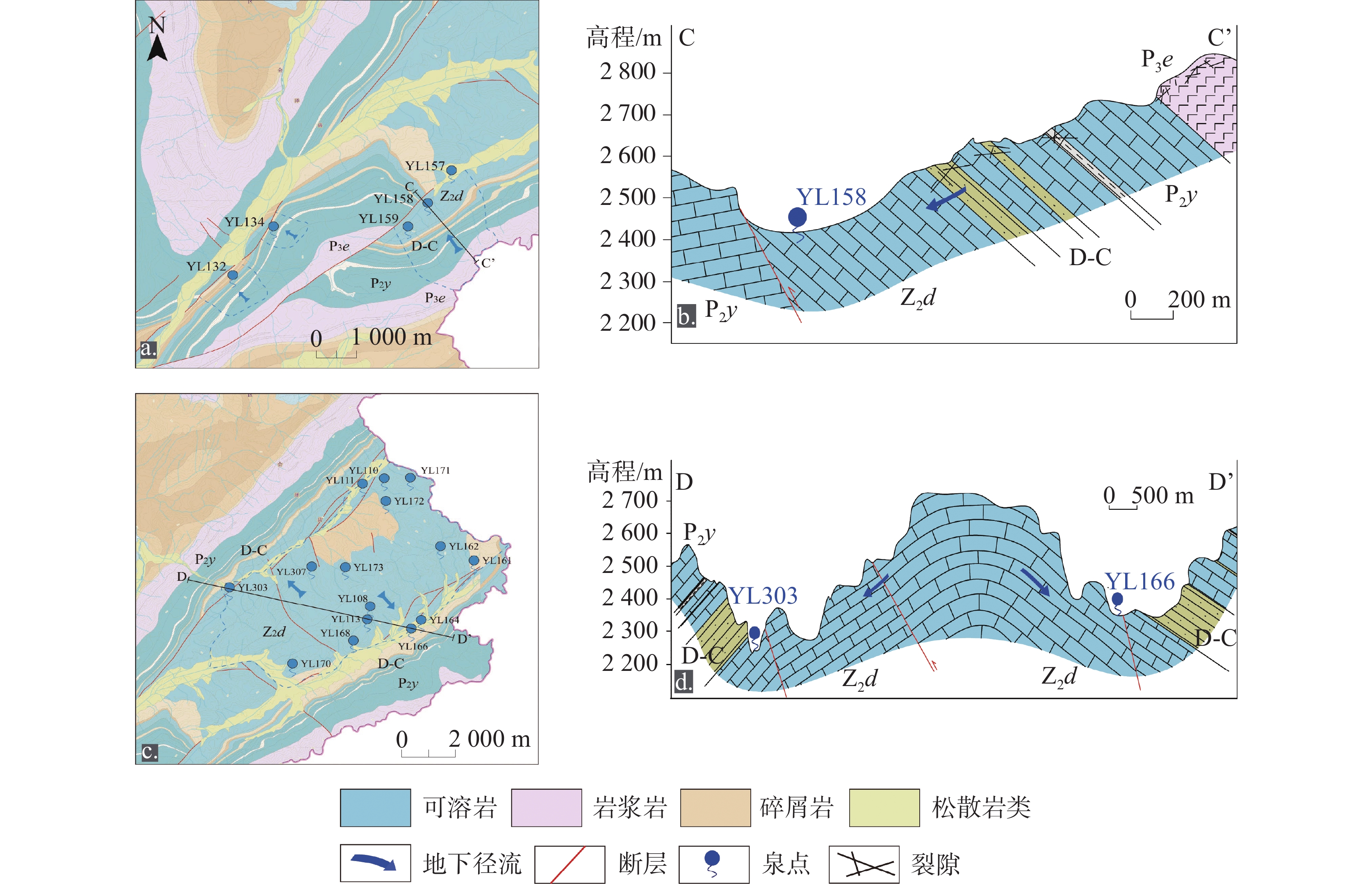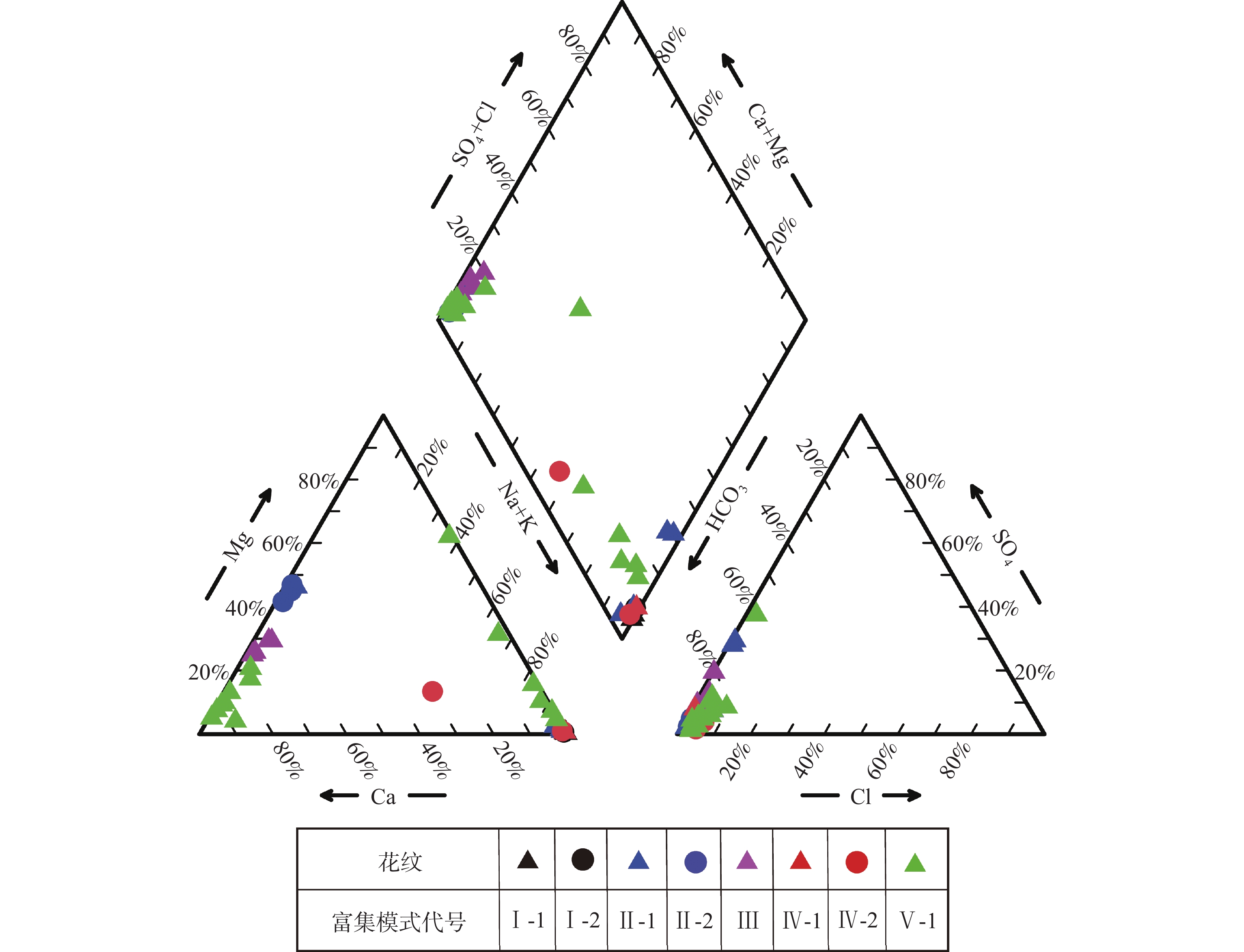Study on the enrichment characteristics and water supply significance of karst groundwater in the Yili river basin, Wumeng Mountain area
-
摘要:
岩溶地下水是乌蒙山集中连片贫困区内居民生产生活的主要水源,归纳区内地下水富集特征并探讨岩溶地下水的供水意义对于当地地下水资源勘察和开发利用具有重要的现实意义。文章针对乌蒙山以礼河中上游区域,基于现场水文地质调查,对水样进行采样和测试,并结合地下水天然资源量的计算方法,归纳总结了研究区内岩溶地下水的富集特征,并结合富水程度、供水条件和水质特征三个方面探讨了岩溶水的供水意义。研究得到以下结论:(1)研究区内岩溶地下水的富集特征可归纳为五种类型:断裂导水带、断裂溶蚀谷、条带溶蚀谷、褶皱溶蚀谷、阻水接触带;(2)富水块段内地下水化学类型以Na-HCO3型和Ca·Mg-HCO3型为主,水质整体较好,I~III类水占比为79%,超标指标主要为硝酸盐和耗氧量;(3)各富水块段地下水的天然补给量和排泄量分别为329.7~14 512.4万m3·a−1和4.6~1 308.4万m3·a−1,排泄量占补给量比值为0.3%~15.5%,区内地下水资源剩余开发潜力较大;(4)断裂溶蚀谷、条带溶蚀谷和阻水接触带供水意义显著,其余富水块段在不同程度上受限于水资源时空分配不均、不具备供水条件、水质较差等情况,其供水受到影响。
Abstract:The deepened karst development caused by its uneven development of karst and significant uplift of the Cenozoic crust results in the extremely uneven spatial and temporal distribution of karst groundwater, which makes it very difficult to extract and utilize groundwater. Therefore, understanding the enrichment law of karst groundwater is of great significance for the exploration and development of groundwater resources. Karst groundwater is the main water source for local people's production and life in the contiguous poverty-stricken area in Wumeng Mountain area, Southwest China. Hence, summarizing the characteristics of groundwater enrichment and studying the significance of karst groundwater supply can provide important references for the exploration and utilization of local groundwater resources.
Firstly, this study conducted a hydrogeological survey of 1: 100,000 in the upper and middle reaches of the Yili river basin covering an area of 1,400 km2 and another survey of 1: 50,000 in Huize county of Qujing City, with an area of 450 km2. In the surveys, five types of groundwater enrichment characteristics in the study area have been identified through a comprehensive analysis of the spatial distribution and composition of karst water-bearing rock formations, the mechanism of structural groundwater control, and topography. In addition, 133 groundwater samples were collected and tested in the study area, and the main groundwater chemical types and water quality conditions of each groundwater enrichment block were analyzed. Subsequently, factors such as the distribution of watersheds, the spatial distribution and composition of water-bearing rock formations, the spatial morphology of faults and folds, and the catchment area of springs were taken into consideration to delineate the groundwater enrichment blocks corresponding to each spring or spring group. The natural recharge and discharge of groundwater in each groundwater enrichment block were calculated according to the rainfall infiltration coefficient and the total discharge. Finally, based on the previous research, the significance of groundwater supply by karst springs is concluded in terms of the groundwater abundance, supply conditions, and quality.
The study results show that the enrichment characteristics of karst groundwater in the study area can be summarized into five types: fault-conducting zone, fault dissolution valley, strip dissolution valley, fold dissolution valley, and water-blocking contact zone. Besides, Na-HCO3 and Ca·Mg-HCO3 are the main groundwater chemical types in the enrichment blocks. 79% of groundwater is classified as type I to type III with nitrate and oxygen consumption as the main indicators exceeding the permitted level. Moreover, the natural recharge and discharge of groundwater in each groundwater enrichment block are 3,297,000-145,124,000 m3·a−1 and 46,000-13,084,000 m3·a−1 respectively. The ratios of discharge to recharge are 0.3%-15.5%, which indicates considerable potential of exploiting groundwater resources. Finally, the water enrichment blocks such as fault dissolution valley, strip dissolution valley, and water-blocking contact zone are of marked significance in water supply. Limited by the uneven spatial and temporal distribution of groundwater resources, shortage of water supply, poor water quality, etc., the other types of water enrichment blocks are of less significance. The research results provide a theoretical basis for ensuring water safety in poor water-scarce regions.
-

-
表 1 研究区地下水水质特征汇总表
Table 1. Summary of groundwater quality in the study area
I(N1=3) II(N=8) III(N=4) IV(N=3) V(N=15) I-1(N=2) I-2(N=1) II-1(N=5) II-2(N=3) \ IV-1(N=1) IV-2(N=2) V-1 检测
参数2,3pH 7.9/0.4 7.9/0 8.0/1.9 7.9/0.9 7.9/2.1 8.2/0 7.9/0.4 7.9/1.7 K+ 495.5/24.7 80/0 13.1/122.6 1.0/12.8 0.9/33 0/0 22/100 20.6/312.8 Na+ 0/0 63.6/0 7.4/106.9 1.6/13.4 1.7/58.7 87/0 0.6/100 20.7/145.6 Ca2+ 0.3/6.5 0.6/0 9.6/196.4 49.8/14.7 39.1/8.7 0.2/0 0.4/53.2 52.4/96.7 Mg2+ 0.5/10 0.4/0 5.4/193.1 25.0/11.5 9.5/17.7 0.3/0 0.1/9.1 9.2/152.5 Cl− 2.3/2.6 3.4/0 3.2/106.5 3.1/15.3 1.9/81 1.2/0 2.5/22.9 7.2/76.7 ${\rm{SO}}_4^{2-}$ 5.1/13.2 11.5/0 30.2/82 7.7/35.6 18.5/38.6 15/0 1.7/9.5 20.4/158.9 ${\rm{HCO}}_3^{-}$ 155.7/0 217.9/0 196.1/13.8 259.4/11.3 148.7/8.2 217.9/0 85.6/34.6 246.1/33.1 ${\rm{NO}}_3^{-}$ 4/10.6 5.8/0 5.4/158.3 10.0/21.6 2.5/91.2 1.7/0 0/0 13.3/77.2 TDS 139.8/1.3 199.3/0 205.4/18.8 221.1/11.6 148.1/11.9 190.8/0 74.4/32.4 245.2/39.1 地下水
类型Na-HCO3 Na-HCO3 Na-HCO3(N=4)
Ca·Mg-HCO3(N=1)Ca·Mg-HCO3 Ca·Mg-HCO3 Na-HCO3 Na-HCO3(N=1)
Ca·Na-HCO3(N=1)Ca-HCO3(N=9)
Na-HCO3(N=5)
Na·Mg- HCO3·SO4(N=1)地下水质
量分级III III III(N=4), IV(N=1) III(N=2), IV(N=1) I(N=1) II(N=1)
III(N=1) IV(N=1)IV III II(N=11), III(N=1)
IV(N=2), V(N=1)注:1N为样本数;2物化参数一栏中,pH无量纲,其余参数单位均为mg·L−1;3物化参数数据格式为:样本均值/变异系数(%)。
Note: 1N represents sample size. In the column of 2physicochemical parameter, pH is dimensionless; the unit of other parameters is mg·L−1. The data format of 3physicochemical parameter is sample average/coefficient of variation(%)表 2 研究区富水块段天然补给量计算参数取值及结果统计一览表
Table 2. Values and results of calculation parameters of the natural recharge in water enrichment blocks
富水块段 子区 入渗系数 $ \alpha $ 泉域面积F/km2 多年平均降雨量H/mm Q补/万 m3·a−1 I I-1 0.33 2.22 817.7 599 I-2 0.56 3.81 1744.6 II II-1 0.41 5.26 1763.5 II-2 0.49 36.22 14512.4 III \ 0.12 21.34 2094.0 IV IV-1 0.37 4.61 1394.8 IV-2 0.21 1.92 329.7 V \ 0.52 23.13 9835.0 表 3 研究区富水块段天然排泄量计算参数取值及结果统计一览表
Table 3. Values and results of calculation parameters of the natural discharge amount in water enrichment blocks
富水块段 子区 丰水期1 平水期2 枯水期3 Q排/
万m3·a−1Q排/
Q补系数 流量L·s−1 系数 流量L/s 系数 流量L·s−1 II II-1 3 121.4* 1.5 60.7 1 40.47 230.8 13.1% II-2 3 57.68* 1.5 28.84 1 19.23 109.6 0.7% III \ 2.5 43.84* 1.3 22.8 1 17.54 87.3 4.2% IV IV-1 2 2.1* 1.2 1.26 1 1.05 4.6 0.3% IV-2 3.5 27.4* 1.8 14.09 1 7.83 51.1 15.5% V V-1 4 721.1 2 360.55* 1 180.28 1308.4 13.3% 1丰水期为每年6月、7月、8月、9月;2平水期为每年3月、4月、5月、10月;3枯水期为每年1月、2月、11月、12月;*流量为调查实测流量
1Wet season: from June to September; 2Normal season: from March to May and October; 3Dry season: from January to February and from November to December. *The flow is the actual measurement in the survey表 4 各富水块段供水意义评价要素与评价结果一览表
Table 4. Evaluation elements and results of water supply significance in water enrichment blocks
富水块段 子区 评价要素 供水意义
评价结果富水程度 供水条件 水质特征 I I-1 水资源时空分配极不均,
仅雨季富水不具备天然供水条件 III类水,水质较好 较差 I-2 水资源时空分配较不均,
旱季易断流泉水经水渠流经居民区,
具备天然供水条件III类水,水质较好 较好 II II-1 良好的补给条件和
富水空间泉点位于用水户上方,
自然引流条件较好绝大部分优于III类水,
个别泉点为IV类水显著 II-2 III \ IV IV-1 良好的补给条件和
富水空间泉点自然引流用于居民
生活和灌溉用水IV类水,耗氧量超标 农业用水:较好
居民用水:较差IV-2 泉点高程较高,
附近无用水户III类水,
水质较好较差 V V-1 良好的补给条件和富水空间,
地下水资源量丰富泉点自然引流用于居民生活
和灌溉,且已修建蓄水设施大部分优于III类水,个别
泉点为IV类水和V类水显著 V-2 -
[1] 郭蕾蕾, 魏良帅, 黄安邦, 舒勤峰. 乌蒙山地区岩溶地下水流系统结构及其找水应用[J]. 地质科技通报, 2022, 41(1):146-156.
GUO Leilei, WEI Liangshuai, HUANG Anbang, SHU Qinfeng. Structure of karst groundwater system and its water exploration in Wumeng Mountain area[J]. Bulletin of Geological Science and Technology, 2022, 41(1):146-156.
[2] 魏良帅, 黄安邦, 罗雲丰, 贾逸, 舒勤峰, 和铭. 乌蒙山昭通地区玄武岩地下水赋存规律及开发利用[J]. 地质通报, 2020, 39(12):1891-1898. doi: 10.12097/j.issn.1671-2552.2020.12.003
WEI Liangshuai, HUANG Anbang, LUO Yunfeng, JIA Yi, SHU Qinfeng, HE Ming. Occurrence regularity and exploration and utilization of groundwater in Zhaotong area of Wumeng Mountain[J]. Geological Bulletin of China, 2020, 39(12):1891-1898. doi: 10.12097/j.issn.1671-2552.2020.12.003
[3] 洪涛, 谢运球, 喻崎雯, 赵一, 赵光帅, 杨丽超. 乌蒙山重点地区地下水水化学特征及成因分析[J]. 地球与环境, 2016, 44(1):11-18. doi: 10.14050/j.cnki.1672-9250.2016.01.002
HONG Tao, XIE Yunqiu, YU Qiwen, ZHAO Yi, ZHAO Guangshuai, YANG Lichao. Hydrochemical characteristics study and genetic analysis of groundwater in a key region of the Wumeng Mountain, Southwestern China[J]. Earth and Environment, 2016, 44(1):11-18. doi: 10.14050/j.cnki.1672-9250.2016.01.002
[4] 钱康, 张继, 陈鹏, 蒲文斌, 陈贝贝, 魏良帅. 云南乌蒙山盘河地区地下水水化学及同位素特征[J]. 地质通报, 2022, 41(7):1291-1299.
QIAN Kang, ZHANG Ji, CHEN Peng, PU Wenbin, CHEN Beibei, WEI Liangshuai. Hydrochemical and isotopic characteristics of groundwater in Panhe area of Wumeng Mountain, Yunnan[J]. Geological Bulletin of China, 2022, 41(7):1291-1299.
[5] 曹建华, 袁道先, 章程, 蒋忠诚. 受地质条件制约的中国西南岩溶生态系统[J]. 地球与环境, 2004, 32(1):1-8. doi: 10.3969/j.issn.1672-9250.2004.01.001
CAO Jianhua, YUAN Daoxian, ZHANG Cheng, JIANG Zhongcheng. Karst ecosystem constrained by geological conditions in Southwest China[J]. Earth and Environment, 2004, 32(1):1-8. doi: 10.3969/j.issn.1672-9250.2004.01.001
[6] 樊连杰, 邹胜章, 解庆林, 卢丽, 林永生, 朱丹尼, 王佳, 周长松, 李军. 乌蒙山区地下水赋存独特性与开发利用模式:以昭觉地区为例[J]. 地质学报, 2021, 95(11):3544-3555. doi: 10.3969/j.issn.0001-5717.2021.11.026
FAN Lianjie, ZOU Shengzhang, XIE Qinglin, LU Li, LIN Yongsheng, ZHU Danni, WANG Jia, ZHOU Changsong, LI Jun. Unique characteristics of groundwater occurrence and its development and utilization model in the Wumeng Mountain area: A case study of the Zhaojue area[J]. Acta Geologica Sinica, 2021, 95(11):3544-3555. doi: 10.3969/j.issn.0001-5717.2021.11.026
[7] 刘光亚. 基岩地下水[M]. 北京: 地质出版社, 1979.
[8] 廖资生. 北方岩溶的主要特征和岩溶储水构造的主要类型[M]. 北京: 地质出版社, 1978: 56-61.
[9] 胡宽瑢, 曹玉清, 胡忠毅, 刘星. 水文地质蓄水构造级、区带划分及其水资源分布特点[J]. 长春科技大学学报, 2000, 30(3):246-250. doi: 10.3969/j.issn.1671-5888.2000.03.009
HU Kuanrong, CAO Yuqing, HU Zhongyi, LIU Xing. Hydrological impounded structure classification and its zone division[J]. Journal of Changchun University of Science and Technology, 2000, 30(3):246-250. doi: 10.3969/j.issn.1671-5888.2000.03.009
[10] 梁永平, 王维泰. 中国北方岩溶水系统划分与系统特征[J]. 地球学报, 2010, 31(6):860-868.
LIANG Yongping, WANG Weitai. The division and characteristics of karst water system in Northern China[J]. Acta Geoscientica Sinica, 2010, 31(6):860-868.
[11] 乔晓英, 王文科, 陈英, 王杰, 韩锦萍, 梁煦枫. 天山北麓蓄水构造模式与水循环特征[J]. 地球科学与环境学报, 2005, 27(3):33-37. doi: 10.3969/j.issn.1672-6561.2005.03.009
QIAO Xiaoying, WANG Wenke, CHEN Ying, WANG Jie, HAN Jinping, LIANG Xufeng. Storage water structure modes and water cycle characteristic on Tianshan Mountain foot[J]. Journal of Earth Sciences and Environment, 2005, 27(3):33-37. doi: 10.3969/j.issn.1672-6561.2005.03.009
[12] 李巨芬, 李伟, 冯庆达, 吕琳, 马雪梅. 山东临朐盆地新构造运动特征及其对地下水的控制作用[J]. 水文地质工程地质, 2020, 47(1):28-36. doi: 10.16030/j.cnki.issn.1000-3665.201809139
LI Jufen, LI Wei, FENG Qingda, LYU Lin, MA Xuemei. Characteristics of the new tectonic movement and its control of groundwater in the Linqu basin in Shandong[J]. Hydrogeology & Engineering Geology, 2020, 47(1):28-36. doi: 10.16030/j.cnki.issn.1000-3665.201809139
[13] 刘新号. 基于蓄水构造类型的山区综合找水技术[J]. 水文地质工程地质, 2011, 38(6):8-12. doi: 10.16030/j.cnki.issn.1000-3665.2011.06.019
LIU Xinhao. Integrated techniques of locating groundwater in mountain areas based on groundwater-impounding types[J]. Hydrogeology & Engineering Geology, 2011, 38(6):8-12. doi: 10.16030/j.cnki.issn.1000-3665.2011.06.019
[14] 于丽莎, 潘晓东, 曾洁, 任坤, 焦友军, 兰干江. 鲁中南泰莱盆地岩溶地下水赋存特征和找水规律[J]. 地质与勘探, 2019, 55(1):168-177. doi: 10.12134/j.dzykt.2019.01.017
YU Lisha, PAN Xiaodong, ZENG Jie, REN Kun, JIAO Youjun, LAN Ganjiang. Occurrence characteristics of karst groundwater and the rule of water search in the Tailai basin, central-southern Shandong Province[J]. Geology and Exploration, 2019, 55(1):168-177. doi: 10.12134/j.dzykt.2019.01.017
[15] 汪云, 杨海博, 郑梦琪, 赵耀, 韩智昕. 泰莱盆地地下水蓄水构造特征及勘查定井研究[J]. 水利水电技术, 2019, 50(3):52-65. doi: 10.13928/j.cnki.wrahe.2019.03.007
WANG Yun, YANG Haibo, ZHENG Mengqi, ZHAO Yao, HAN Zhixin. Study on characteristics of groundwater storage structures and well explorating and locating within Tailai basin[J]. Water Resources and Hydropower Engineering, 2019, 50(3):52-65. doi: 10.13928/j.cnki.wrahe.2019.03.007
[16] 潘晓东, 唐建生, 苏春田. 鲁中南地区岩溶水系统模式:以泰安市岱岳区为例[J]. 桂林理工大学学报, 2014, 34(1):39-44.
PAN Xiaodong, TANG Jiansheng, SU Chuntian. Karst groundwater system in central and southern Shandong province: A case in Daiyue district of Tai'an[J]. Journal of Guilin University of Technology, 2014, 34(1):39-44.
[17] 杨红, 许模, 张劲松. 滇东南弥勒盆地蓄水构造特征分析及找水方向[J]. 水土保持研究, 2012, 19(6):254-258.
YANG Hong, XU Mo, ZHANG Jinsong. Analysis of the characteristics of groundwater storage structure and groundwater exploration in Mile basin, southeast Yunnan Province[J]. Research of Soil and Water Conservation, 2012, 19(6):254-258.
[18] 覃小群, 宋开本, 黄奇波, 蓝芙宁, 黄春阳, 黄辉. 广西岩溶峰林区地下水赋存特征及钻探成井模式[J]. 中国岩溶, 2017, 36(5):618-625.
QIN Xiaoqun, SONG Kaiben, HUANG Qibo, LAN Funing, HUANG Chunyang, HUANG Hui. Groundwater occurrence characteristics and drilling well models in karst peak forest areas, Guangxi, China[J]. Carsologica Sinaca, 2017, 36(5):618-625.
[19] 张之淦, 陈伟海. 岩溶蓄水构造与找水:以广西来宾小平阳为例[J]. 水文地质工程地质, 2000(6):1-5. doi: 10.3969/j.issn.1000-3665.2000.06.001
ZHANG Zhigan, CHEN Weihai. Water-bearing structure in karst ternain: A case study in Xiaopingyang area, Laibin, Guangxi[J]. Hydrogeology & Engineering Geology, 2000(6):1-5. doi: 10.3969/j.issn.1000-3665.2000.06.001
[20] 潘晓东, 唐建生, 苏春田, 孟小军, 曾洁, 杨杨. 贵州高原斜坡岩溶地区逆断层两盘地下水开采规律探讨[J]. 地质论评, 2015, 61(1):121-127. doi: 10.16509/j.georeview.2015.01.014
PAN Xiaodong, TANG Jiansheng, SU Chuntian, MENG Xiaojun, ZENG Jie, YANG Yang. Discussion of groundwater exploration in compressive fault zones in karst areas of Guizhou Plateau slopes[J]. Geological Review, 2015, 61(1):121-127. doi: 10.16509/j.georeview.2015.01.014
[21] 屈伟, 丁坚平, 邹仕孝, 曹兴民. 褶皱构造对岩溶泉发育的控制作用: 以贵州威宁地区为例[J]. 地下水, 2009, 31(6):131-133. doi: 10.3969/j.issn.1004-1184.2009.06.052
QU Wei, DING Jianping, ZOU Shixiao, CAO Xingmin. Fold structure's control funtion on the karst stephen development: Taking the Weining region in Guizhou as an example[J]. Ground Water, 2009, 31(6):131-133. doi: 10.3969/j.issn.1004-1184.2009.06.052
[22] 苏春田, 潘晓东, 李兆林, 唐建生, 梁小平, 程洋, 赵伟, 谢代兴, 孟小军. 云南广南岩溶区水文地质环境地质调查进展[J]. 中国地质调查, 2015, 2(8):9-16. doi: 10.19388/j.zgdzdc.2015.08.002
SU Chuntian, PAN Xiaodong, LI Zhaolin, TANG Jiansheng, LIANG Xiaoping, CHENG Yang, ZHAO Wei, XIE Daixing, MENG Xiaojun. Progress of hydrogeology and environmental geology survey in Guangnan karst area, Yunnan Province[J]. Geological Survey of China, 2015, 2(8):9-16. doi: 10.19388/j.zgdzdc.2015.08.002
[23] 彭淑惠, 李继红. 滇东岩溶区表层岩溶水源地特征及其开发利用[J]. 云南地质, 2006, 25(2):249-255. doi: 10.3969/j.issn.1004-1885.2006.02.016
PENG Shuhui, LI Jihong. The characteristics and development of epigenic karst water in east Yunnan[J]. Yunnan Geology, 2006, 25(2):249-255. doi: 10.3969/j.issn.1004-1885.2006.02.016
[24] 任蕊, 杨成程, 匡野. 乌蒙山岩溶缺水地区表层岩溶泉有效开发模式研究[J]. 地下水, 2018, 40(2):24-26.
REN Rui, YANG Chengcheng, KUANG Ye. Study on the exploitation model of epikarst spring karst water Wumengshan area[J]. Ground Water, 2018, 40(2):24-26.
[25] 赵伟策, 祝新友, 王书来, 蒋斌斌, 刘孜, 管育春. 云南会泽铅锌矿灯影组矿石硫、铅同位素组成及找矿意义[J]. 沉积与特提斯地质, 2023, 43(1):156-167. doi: 10.19826/j.cnki.1009-3850.2022.10004
ZHAO Weice, ZHU Xinyou, WANG Shulai, JIANG Binbin, LIU Zi, GUAN Yuchun. Sulfur and lead isotopic compositions of ores from the Dengying Formation and their prospecting implications in the Huize Pb-Zn deposit, Yunnan Province[J]. Sedimentary Geology and Tethyan Geology, 2023, 43(1):156-167. doi: 10.19826/j.cnki.1009-3850.2022.10004
[26] 何师意, 周锦忠, 曾飞跃. 岩溶地下河流域地下水资源评价:以湖南湘西大龙洞为例[J]. 水文地质工程地质, 2007(5):33-36.
HE Shiyi, ZHOU Jinzhong, ZENG Feiyue. Assessment on the karst water resources of Dalongdong underground river catchment of Xiangxi[J]. Hydrogeology & Engineering Geology, 2007(5):33-36.
[27] 杨杨, 赵良杰, 潘晓东, 夏日元, 曹建文. 西南岩溶山区地下水资源评价方法对比研究:以寨底地下河流域为例[J]. 中国岩溶, 2022, 41(1):111-123.
YANG Yang, ZHAO Liangjie, PAN Xiaodong, XIA Riyuan, CAO Jianwen. Comparative study on evaluation methods of groundwater resources in karst area of Southwest China: Taking Zhaidi underground river basin as an example[J]. Carsologica Sinica, 2022, 41(1):111-123.
[28] 劳文科, 蒋忠诚, 时坚, 梁彬. 洛塔表层岩溶带水文地质特征及其水文地质结构类型[J]. 中国岩溶, 2003, 22(4):258-266. doi: 10.3969/j.issn.1001-4810.2003.04.002
LAO Wenke, JIANG Zhongcheng, SHI Jian, LIANG Bin. Hydrogeologic structure and feature of the epi-karst in Luota[J]. Carsologica Sinica, 2003, 22(4):258-266. doi: 10.3969/j.issn.1001-4810.2003.04.002
[29] 云南省地质局水文地质工程地质队. 1: 20万东川幅区域水文地质普查报告[R]. 1980.
[30] 中国地质调查局成都地质调查中心. 乌蒙山滇东北地区以礼河流域水文地质调查报告[R]. 2022
[31] 梁永平, 赵春红. 中国北方岩溶水功能[J]. 中国矿业, 2018, 27(Supp.2):297-299, 305. doi: 10.12075/j.issn.1004-4051.2018.S2.078
LIANG Yongping, ZHAO Chunhong. Karst water function in Northern China[J]. China Mining Magazine, 2018, 27(Supp.2):297-299, 305. doi: 10.12075/j.issn.1004-4051.2018.S2.078
[32] 王宇. 云南泸西小江流域岩溶水有效开发模式研究[D]. 昆明: 昆明理工大学. 2006.
WANG Yu. Effective exploration model of karst water in Xiaojiang basin, Luxi county, Yunnan[D]. Kunming: Kunming University of Science and Technology, 2006.
[33] 王宇. 西南地区岩溶水源地类型及开发技术条件[J]. 中国岩溶, 2009, 28(4):370-374. doi: 10.3969/j.issn.1001-4810.2009.04.006
WANG Yu. Classification and exploitive technical condition of karst water source field in Southwest China[J]. Carsologica Sinica, 2009, 28(4):370-374. doi: 10.3969/j.issn.1001-4810.2009.04.006
-




 下载:
下载:





